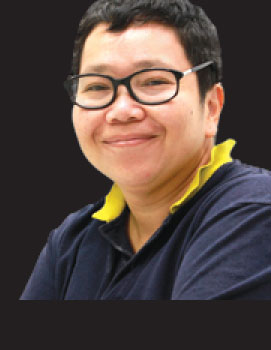
Visitors to Sanam Luang are experiencing the unusual. No, I am not talking about the sea of mourners or tourists clad in black. Nor do I refer to the phalanx of kiosks that are supplying free and delicious food to the mourners.
The unusual scene is the presence of a horde of volunteers who are helping to collect and sort garbage produced in the area. These volunteers carry transparent rubbish bags, each plastered with a label and colour code to specify its assigned type of garbage: plastic bottles, leftover food or general waste.
The volunteers walk around asking people to drop their rubbish in the right bags. The garbage classification helps Bangkok Metropolitan Administration staff to better manage the inevitable piles of rubbish that result.

Anchalee Kongrut writes about the environment in the Life section, Bangkok Post.
With this volunteer work, leftover food is kept in bins to be processed as fertiliser. Plastic bottles are given to scavengers. The volunteers work so efficiently that a librarian at Thammasat University reminded me: "People cannot hold garbage in their hands that long. These volunteers follow them and politely ask to take the garbage from them."
Most volunteers are students who have joined a "Volunteers for Dad" campaign to help reduce trash at Sanam Luang. It is a collaboration of Thammasat University, the BMA, the Ministry of Natural Resources and Environment and BIG Trees, a civic group working on urban environmental conservation.
Waste disposal at Sanam Luang has become the talk of the town in the past two weeks. Indeed, the amount of garbage is reaching 70 to 80 tonnes a day -- equal to half of the waste produced on Samui island each day.
Believe it or not, during the period Oct 19-24, the BMA deployed 1,502 people and 102 trucks to collect garbage at Sanam Luang, of which 37% was leftover food. Good news is that the crisis has been alleviated, as the BMA has started to reclaim two-thirds of the area for the construction of the royal pyre.
Yet, I think we have to thank the BMA's garbage collection teams. We also need to praise the volunteers. Currently, BMA recruits volunteers to sort garbage.
At Sanam Luang, you will also witness a collective and systematic effort to manage waste. For example, right in front of Thammasat University, a kitchen is set up by the university's Faculty of Journalism and Mass Communications to provide freshly cooked food served in proper dishes, not foam containers. Refill glasses and bottles are provided next to drinking water dispensers.
I think these waste management efforts are a good tribute to His Majesty King Bhumibol who pioneered garbage recycling and reuse. Almost 20 years ago, the King initiated a garbage recycling project at Kasetsart University with a facility to produce electricity using biomass derived from landfill.
The King was known for his frugal use of materials -- not readily throwing things away. He reportedly insisted that his watch was to be "repaired", not replaced. He used his toothpaste until the last drop. He is a role model of sufficiency and a good example of waste reduction. Anyone can follow his principles.
For me, the amount of waste at Sanam Luang reflects the national situation. Garbage management in Thailand has been in crisis for years. Unfortunately, society does not pay much attention to it.
Last year, the country produced 26.85 million tonnes of waste, of which 19% was recycled properly and 31% properly disposed of, according to Thailand Environment Institute. Sadly, 50% was dumped in open landfills and caused pollution.
Why has garbage management failed? Is it a lack of proper technology? In my humble opinion, we lack awareness of how our consumption behaviour generates waste that consequently affects the environment. We also don't have systematic measures to reduce waste.
So what should we do? I believe it is time the Ministry of Finance and the Pollution Control Department revive their plan, shelved two decades ago, to collect taxes on producers and consumers of packaged products that generate non-recycleable waste. As for consumers, we must pay for plastic bags when we shop. It is time for a public campaign against styrofoam food containers.
The state should follow in the footsteps of His Majesty the King by offering refill water bottles as gifts to students. (Refill bottles were part of the gifts His Majesty the King gave to children on Children's Day last year.)
The waste disposal at Sanam Luang sends us a loud and clear message: our garbage management is failing to keep pace with our voracious consumption. But we can better handle waste if we become committed to it.
